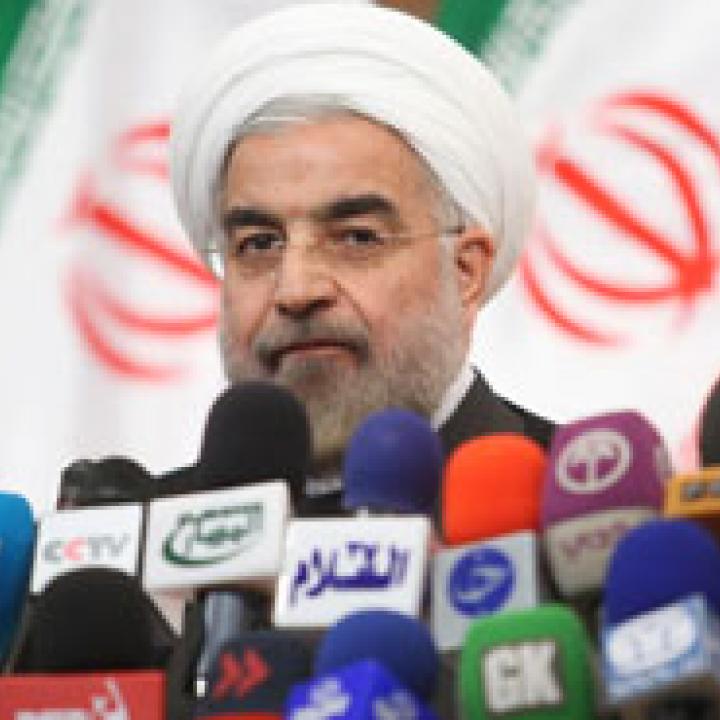

The Iranian president focused on the nuclear file to the exclusion of all other issues, and his country is feeling the consequences today.
U.S. President Donald Trump and Iranian President Hassan Rouhani both attended the UN General Assembly in New York, amid a new phase of tension between the two countries following the unilateral U.S. withdrawal from the nuclear deal known as the JCPOA. No bilateral meetings took place, and if anything, mutual recriminations got louder. If things didn’t get worse, they did not get better.
For the Iranian president, Trump’s decision to walk away from the nuclear agreement not only destroyed several years of diplomatic efforts, it also shattered Rouhani’s own political credentials at home and abroad. The success in nuclear diplomacy could hardly be conceivable without Rouhani’s spectacular endeavor to hyperbolize its immediate life-changing effects in people’s eyes, winning over Khamenei with assurances about the deal’s substantiality and giving the Supreme Leader false hope about its transformational impact on U.S. Middle East policy in favor of Iran.
At the same time, the deal could not have been closed without its portrayal to Western counterparts as an unmatched solution for normalizing Iran and encouraging its leadership to abandon its expansionist, destabilizing foreign policy agenda. The West, Khamenei, and the Iranian people all misperceived the nuclear deal as being transformational in their own favor, but soon after it was signed, its ineffectiveness in delivering the promise of real rapid change became the common subject of complaint on all three sides.
Rouhani used a key as the symbol of his presidential campaign in 2013, implying that negotiation over the nuclear issue was a magic master key that could unlock political and cultural doors, even granting citizens equal rights. Obsessive focus on nuclear issues had at least two ramifications for him. First, from his first day in office, he decided not to press hardliners on non-nuclear issues so as to gain their support or neutralize their sabotage efforts targeting his nuclear policy. Second, by taking for granted that a nuclear deal would be signed, Rouhani left all his eggs in one basket. Rouhani’s government did not have a plan B for any scenario other than the success of the nuclear negotiations with magical consequences.
Ironically, both Trump and Khamenei expressed their discontent about the deal soon after it was signed, long before Trump became president. However, they provide alternative explanations when evaluating the source of today’s crisis in Iran. Trump takes credit for the effects of withdrawing from the deal, reimposing previous sanctions, and adopting new sanctions. On the other hand, Khamenei plays down the role of sanctions in the deterioration of people’s living conditions and blames the government’s mismanagement for the collapse of the Iranian currency and other shocking symptoms of the country’s economic malaise.
One cannot understand Iran without recognizing that none of the country’s crises are new. Historically, the Islamic Republic has proven inept at solving them. In principle, each one could only lose its urgency by creating another, resulting in mounting multi-dimensional challenges with little hope of a way out. The establishment’s determination to block reform efforts and silence democratic demands, on the one hand, and intensifying militarization of the entire government, on the other, atomize the society and depoliticize its citizens.
Probing deeper into the layers of Iranian politics reveals strong resemblances between Iran and other “post-totalitarian” states. At first glance one may find it quite ironic to hear about a strong similarity between Shiite fundamentalism and anti-religious authoritarian empires. However, the post-revolutionary Islamic government was conceived and consolidated by voluntarily following the examples of neighboring tyrannies. Four decades later, there is a strong likeness between Iran’s various faces and fundamental features of post-totalitarian systems in the former Communist bloc.
Rather than noticing and analyzing the crisis Iran faces, the leadership’s approach is to deny, ignore, minimize, or intentionally misformulate its nature. As it worsens, the regime’s vision becomes delusional, driving it to tackle problems by creating greater ones. Crisis can only be born, grown, and multiplied, with no real remedy or end. Hampered and then sidelined by their own errors, the reformers’ initiatives fail, giving birth to a radical team which revives the government’s interests in revolutionary aggression. Ordinary people feel betrayed by both revolution and reform, fatigued by utopian promises paired with traumatic realities.
As a result, the people endure more suffering and become more depoliticized as the best way to survive. The revolutionary military’s terror at home and asymmetric warfare abroad are ceaselessly expanding the boundaries of the crisis. Unable to understand the problematic aspects or fatal ramifications of its policies, the Islamic Republic refuses to realistically recognize any crisis as such, much less to set aside ideological ambitions by correcting failed policies while there is still time to act.
The greater the crisis becomes, the more people tend to ask, “When will the Islamic Republic collapse?” But Iran’s consistent record in acting as an authoritarian, pan-Islamic entity rather than a state based on its national interests prompts an even harder question: “What has kept Iranian revolutionary totalitarianism from falling so far?”
Mehdi Khalaji is the Libitzky Family Fellow at The Washington Institute.
Radio Farda


